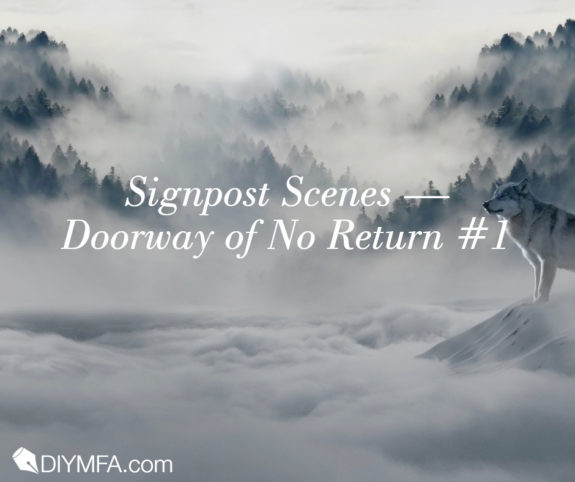Here we go again! Week #5 of James Scott Bell’s 14 signpost scenes, and I promise that you’re in for a big one. Why? Because signpost #5, otherwise known as The Doorway of No Return #1 (The Point of No Return, abbreviated PONR), is one of the three massive, explosive, impossible-to-write-a-story-without plot points. If you’re familiar with DIY MFA founder Gabriela’s universal story theorem (3 Acts + 2 Decisions = 1 Universal Story), this is the first of those two decisions.
And it’s an awesome one.
The Doorway of No Return #1 is the decision your lead must make, the door that all leads must walk through, before the premise becomes “the story.” This is the decision that drops us “down the rabbit hole,” launching us out of our lead’s ordinary world and into the unordinary world of Act II.
But today I’m not going to take you down a rabbit hole (despite the saying’s fame). No, today we’re journeying to Tomi Adeyemi’s magical world of Orïsha. To the Doorway of No Return made in her new beloved debut, Children of Blood and Bone.
How Trouble Brewing (Signpost #4) Builds Tension Prior to Doorway #1
If you read my last signpost scene article (Trouble Brewing), you might be wondering how the Doorway of No Return is different than all the incrementally tense scenes building up to this major decision.
Looking at the big picture, trouble stirs excitement in the first third of a book, but unless something forces a lead (like the rabbit and Alice’s curiosity or Princess Amari and Mama Agba’s prophecy in Children of Blood and Bone) to fight for her life, the story stalls. Trouble gets old. We need new dangers. New threats and obstacles, everyday bad guys and a villain that makes life (and desires) difficult—if not seemingly impossible—for our Lead.
This is why James Scott Bell says trouble brewing is about: “thrusting” the Lead into the story.
The Doorway of No return is the decision that changes the Lead’s life as she knows it, that gives us an adventure like never before. A decision that takes courage, and we all love a lead who has courage.
Zélie Fights for Magic: The Doorway of No Return #1
What’s our aim for the Doorway of No Return #1? Simple. Create the feeling that the instant our Lead crosses door #1’s threshold, there is no turning back. Nada. None.
This is it!
Because to go back means instant death (whether physical, psychological, professional, or a combination of the three). And no Lead wants to die unless they want the premise to remain an idea—a cool thought that never grows into a story.
Take Zélie Adebola.
Here, in the deprived soil of Orïsha, lives the daughter of a murdered Reaper, one of the maji chosen by the gods to yield a special source of magic. As a child, Zélie cherished magic, a source of cosmic power controlled in a home where “Burners ignited flames and Tiders beckoned waves,” and Reapers like her mother summoned dead spirits.
But when the king demanded the death of the maji, he led a violent raid that slaughtered the maji (including Zélie’s mother) and her people’s hope. That is, until Zélie rescues the rebel Princess Amari, the princess who stole an ancient artifact that possess the power needed to save magic.
Now, Zélie has a choice to make, which will lead to greater challenges and a life-altering task.
Her Doorway of No Return: trust the gods and bring the artifact to the sacred temple, or die (along with the death of magic).
If you’ve read Adeyemi’s YA Fantasy bestseller, you know she takes the scroll, the princess, her brother, and runs. Of course she runs. To stay still is to die. To do nothing ends the story. To give up secures the death of magic. Forever.
And Zélie can’t let the king destroy her family and magic!
Read this passage from page 97 (Children of Blood and Bone) to see the Doorway of No Return Zélie crosses at the climax of Act I. Here, there is a clear establishment of death, physical and psychological. And Zélie knows that to turn back, to ignore her destiny, is to die:
You can stay down here, a small thought whispers. You don’t have to continue this fight…
I hold on to the world for a moment, grasping my only chance for escape. But when my lungs wheeze, I force my legs to kick, bringing me back to the broken world I know.
No matter how much I crave peace, the gods have other plans.
Your Turn To Jump Down the Rabbit Hole
Not every Doorway of No Return is the right one for your story. Usually this Doorway appears at the 1/5 mark of your book (in movies it’s usually the ¼ mark), and it should stand out from all the trouble pushing your lead to her decision.
Lucky for you, I have some helpful questions to help you assess if your Doorway of No Return is the best for your story. Ask yourself these questions about your Doorway of No Return, and if the answer is no, try revising and sharing it with your fellow writer friends.
1) Do you know the death stakes of your story (psychological, physical, professional, or a combination)? Does your Doorway of No Return save your lead from this kind of death?
2) Did you write a scene that forces your Lead into the confrontation of Act II?
3) Is your Doorway of No Return strong enough? Can the Lead ignore the Doorway of No Return? Or will they die (see your answer to question #2) if they don’t make it?
4) Does your Doorway of No Return occur at the 1/5 mark? On some occasions, the Doorway of No Return can happen before this mark (as long as there’s enough trouble set up prior), but don’t go past it. If you did, look back at your story/outline. Is there a bigger decision before your assumed Doorway of No Return? Do you need to revise some decisions?
Start by commenting below in the discussions and sharing this link, using #LetsTalkBooks!
 Abigail K. Perry is a speculative fiction writer living in Massachusetts where she teaches creative writing and film production. She received her B.S. in TV, Radio, and Film from Syracuse University and her Master’s in Education from Endicott College. She worked as a creative production intern in for Overbrook Entertainment and as a marketing and sales intern for Charlesbridge Publishing, and currently works as an editorial intern for P.S. Literary.
Abigail K. Perry is a speculative fiction writer living in Massachusetts where she teaches creative writing and film production. She received her B.S. in TV, Radio, and Film from Syracuse University and her Master’s in Education from Endicott College. She worked as a creative production intern in for Overbrook Entertainment and as a marketing and sales intern for Charlesbridge Publishing, and currently works as an editorial intern for P.S. Literary.
Abigail is a member of the DIY MFA street team and a loyal follower of Writer’s Digest, where she has attended various conferences, retreats, workshops, and webinars. You can read more about her work on her website www.akperry.com or follow her on Twitter @A_K_Perry







